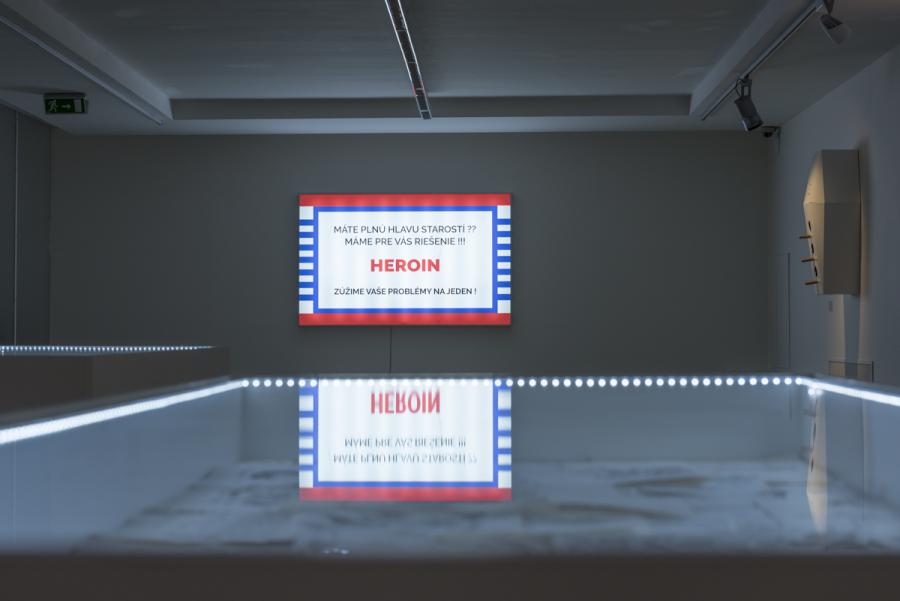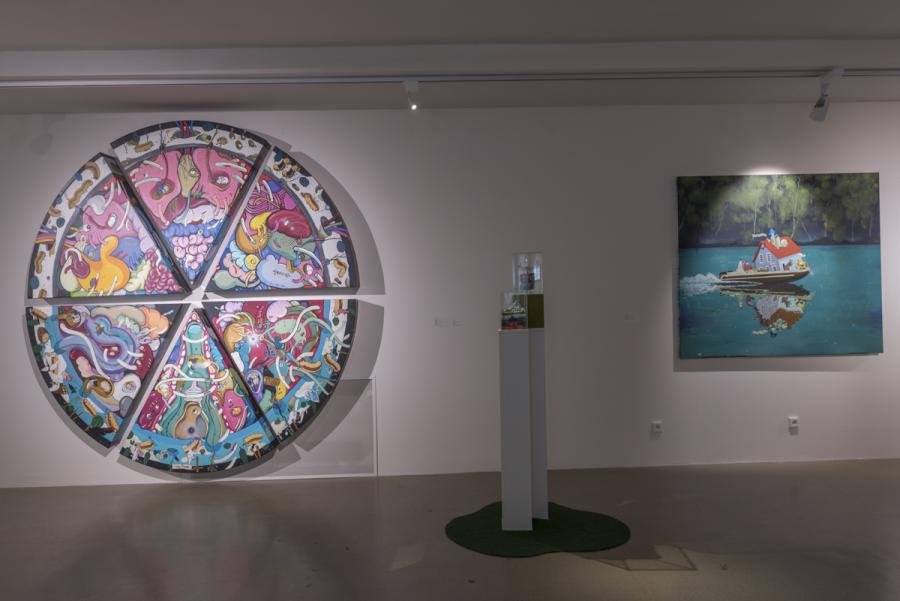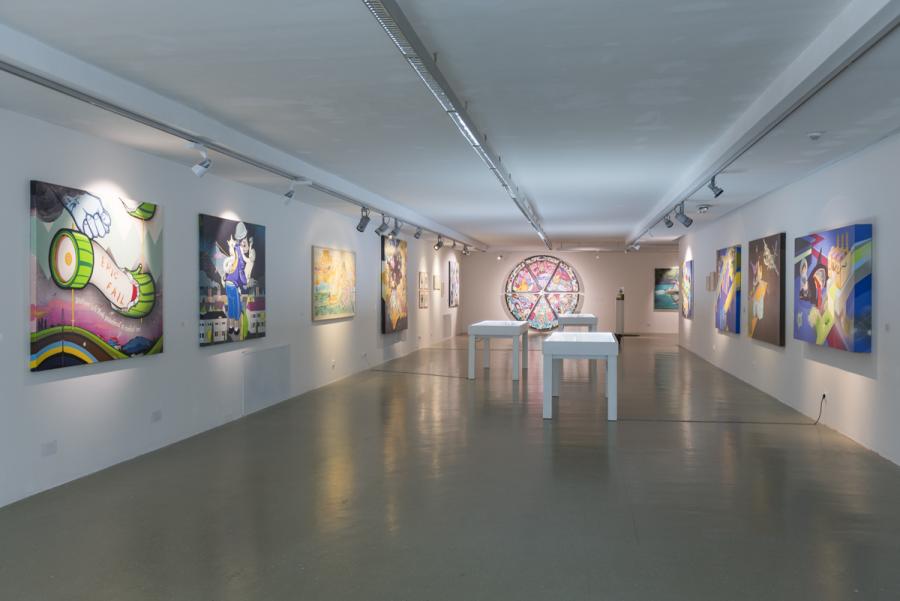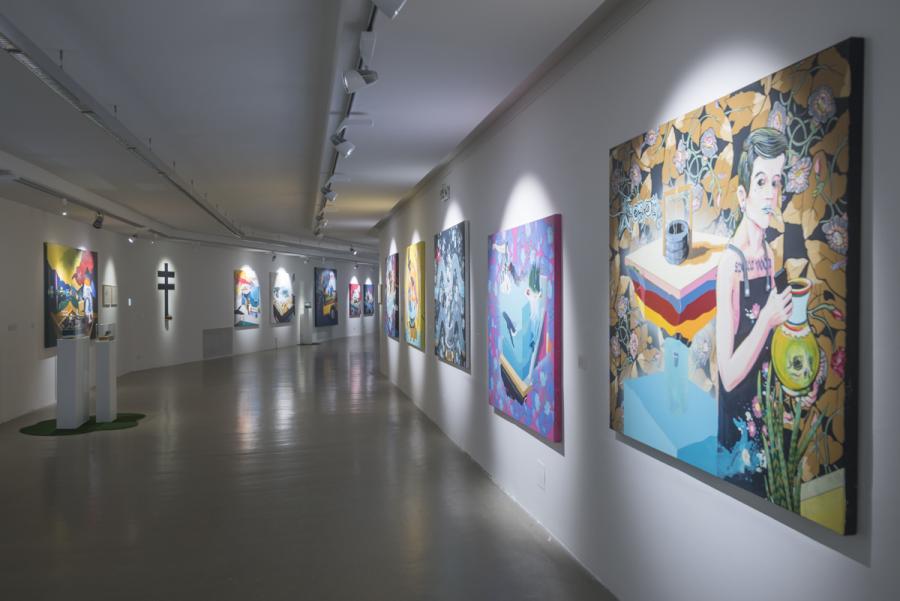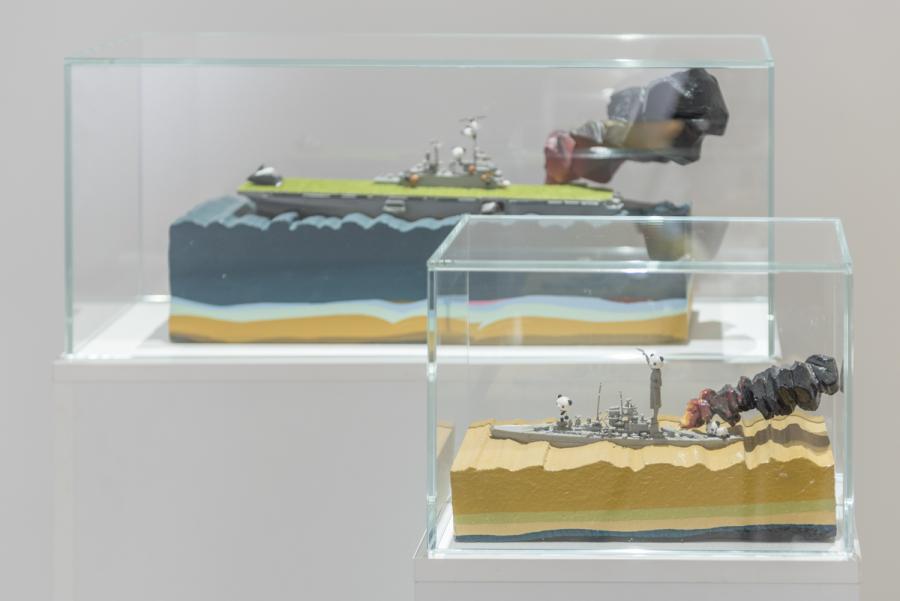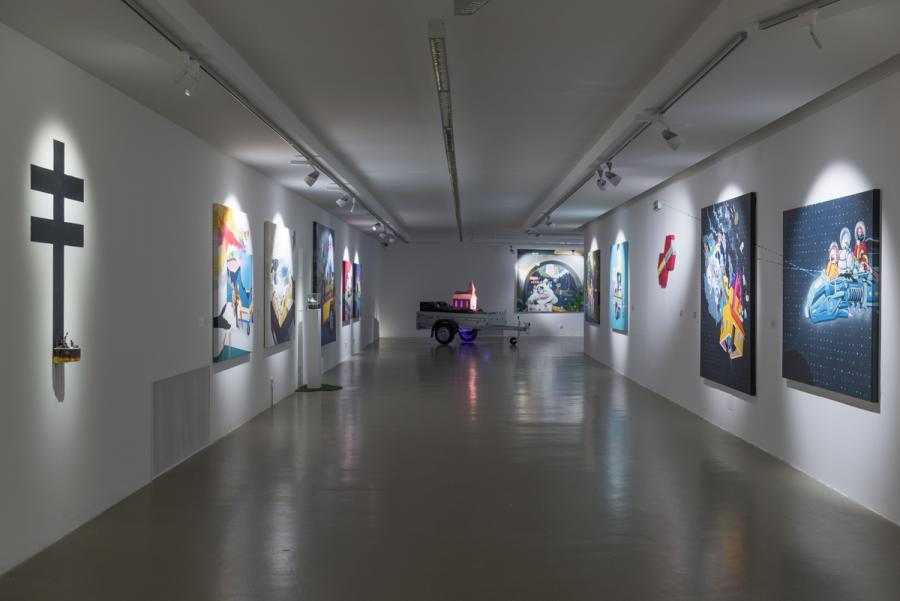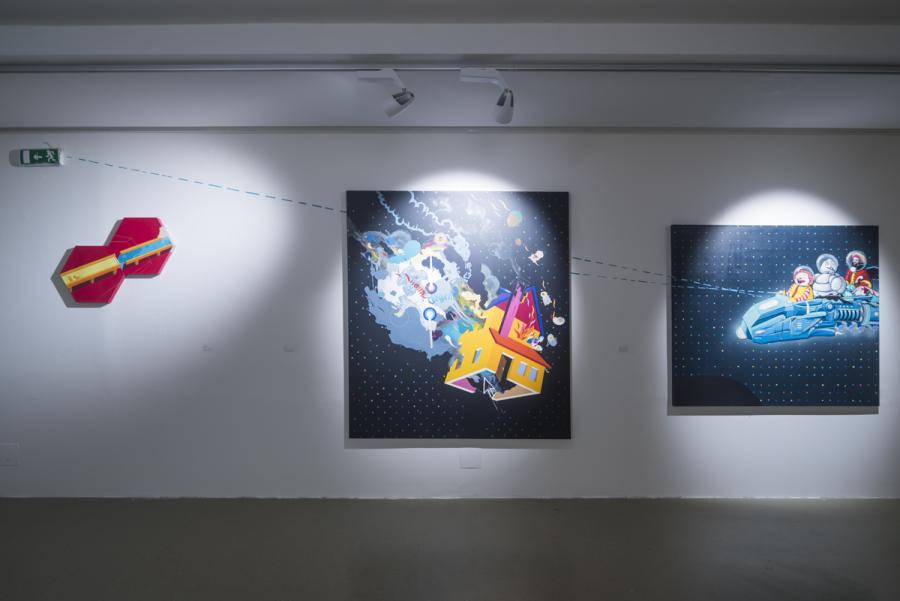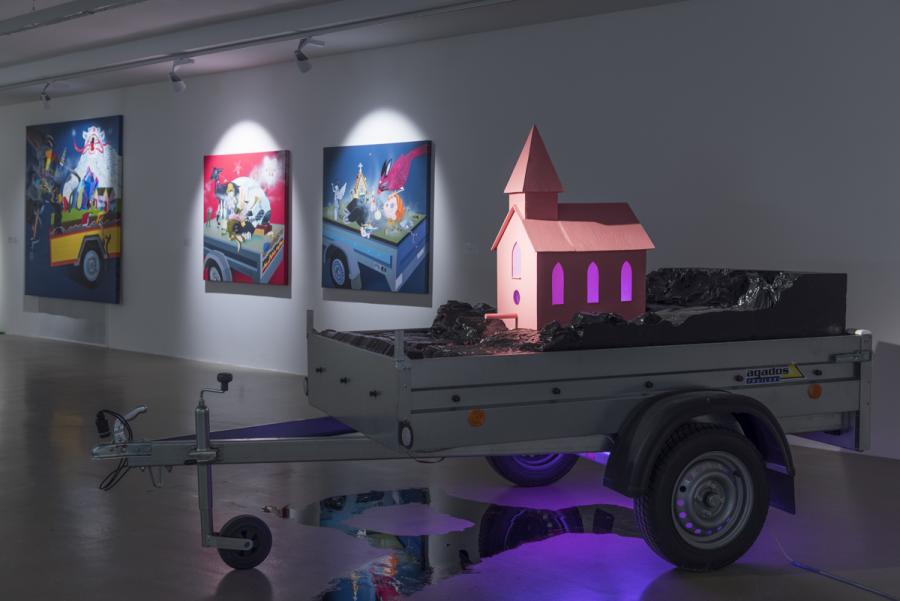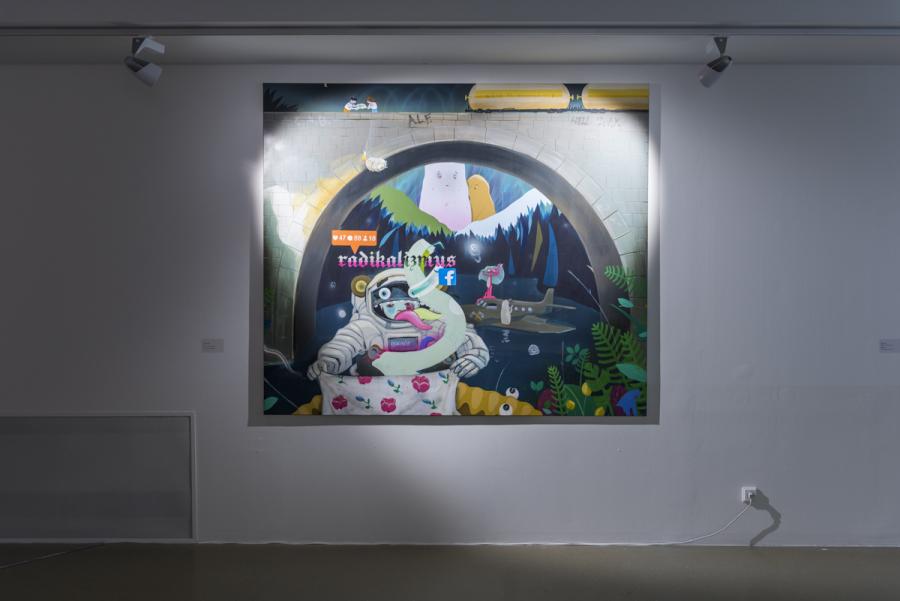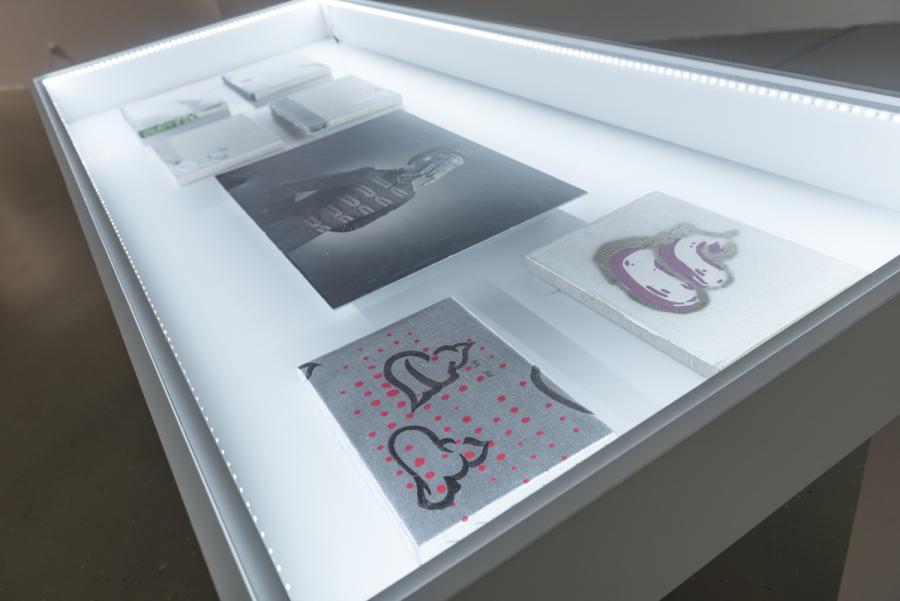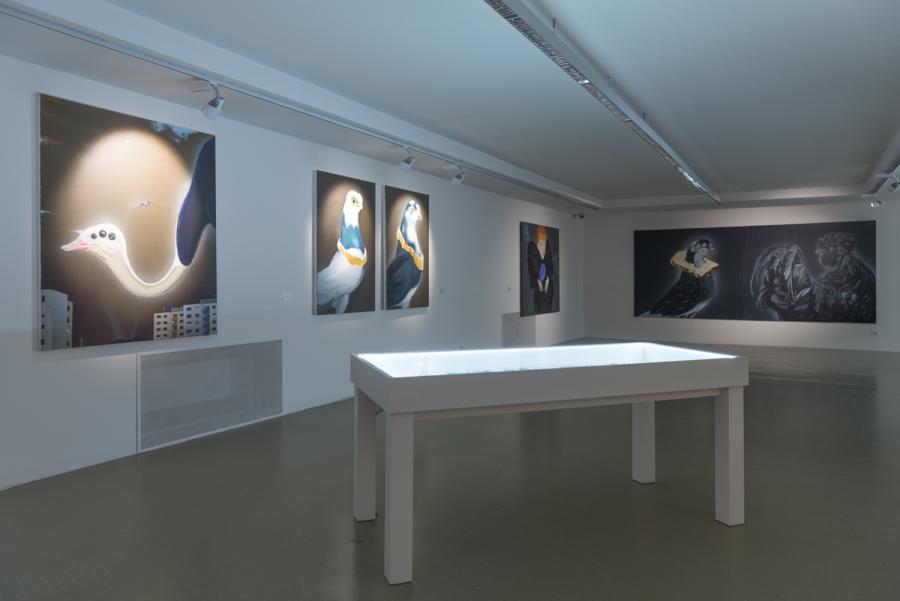error
Painting exhibitions were a true phenomenon in the beginning of the millennium, associated with the “boom of young painting” after 2000, when the medium filled exhibition halls, auction catalogs and evoked media interest. At that time, painting was presented at possibly all institutions and even Aurel Hrabušický had an individual opinion on it.
The inclusion of Erik Šille’s monographic exhibition in the KHB exhibition plan is not a residuum of the recent past, but rather a certain test or an examination of it. Instead of synthesizing overviews, we focused on one prominent protagonist, through which we attempt to pay off the imaginary debt to the entire generation of painters; we’ve set a task to prepare an inventive painting exhibition to see if the boom was just a bubble or a true reflection of the viable evolution of the scene.
As we perceive KHB as a space for living art, experimentation, and creative reception of art, we’ve decided to enhance the exhibition with something special; we didn’t want to create a classic monograph museum exhibition – our aim was to offer the audience something more. That is why we have asked Laco Teren, who is not only a 1980s painter, but also a “connoisseur”, to cooperate with Erik as a curator. The resulting exhibition will be an autonomous work presenting paintings and objects (Šille), but also the “painter’s perspective” or an opinion (Teren), as well as their communication. Thus, a conventional monograph has turned into an experiment – a contemporary gesamtkunstwerk.
Nothing is original. Steal from anywhere that resonates with inspiration or fuels your imagination… And don’t bother concealing your thievery – celebrate it if you feel like it. In any case, always remember what Jean-Luc Godard said: “It’s not where you take things from – it’s where you take them to.”
Jim Jarmusch
This quotation introduced the work of Erik Šille (*1978, Rožňava) in the catalogue Painting after Painting (Slovak National Gallery, 2010) and in many ways rendered the work of undoubtedly the most successful painter of his generation. He raised attention already during his studies at the studio of Professor Ivan Csudai, when a strong “acrylic generation” of painters emerged. Although Šille belongs to its prominent representatives, he continually continually cultivates, develops and enriches his highly distinctive style with new elements and characters. Possibly the most characteristic feature of Šille’s work is his sophisticated symbolism that utilizes the form, charm, and ambiguity of the animated world and comic characters.
Šille’s paintings incorporate the aesthetics and several practices applied in creating comic books and animated films. The author layers protagonists and hidden graphic abbreviations (the symbols of objects and activities) in the complex painting elements on a monochrome background, blending the images, symbols, and aesthetics of Eastern and Western culture. He feels free to quote the symbolic and formal richness of the images of the European cultural context and combines The Barque of Dante, Böcklin and South Park in the paintings Last Boating (2009) or Hello History (2010). By combining art history with pop-culture, he creates new contemporary pseudo-motifs and hybrid fairytales; his paintings seem like landscapes, portraits, and still lifes transplanted from an unknown artificial land behind the computer.
Even the style of his paintings is evolving and shifting over time. Diverting from the graphically pure and accurate, almost “computed” style, to which the author also submits many calligraphic references, his paintings gradually feature more and more “hand-made” deviations and disturbances in the form of gestural brush strokes – certain local “fumigations”. However, all these deviations are always incorporated into a single dynamic composition. In addition to the content, Šille’s work is characterized by a “poisonous” bold coloring. As the bold and bright colors are gradually taken over by an excessive volume of dark tones that correspond to the chosen themes and the noir poetics becomes increasingly more present in the plot of the paintings, the sky gets darker, the clouds get heavier, and the wounds of the characters are opening…
When Erik approached me at a table at Bruno’s to curate his exhibition, it immediately occurred to me that we had to do it in order „to make ourselves, and thus the others happy“; that is the others who come to see the show. With that mantra in mind, I agree with David Hockney’s statement that what we call art is always made with the intention to be looked at; for the second to the last visitor, and in that way also for oneself. Art is not made to be stuffed in a drawer or stocked behind the cupboard, but to be hanged on the walls of galleries, so that everyone can see it. No further explanation is necessary. If I’m making/painting something, it is for personal reasons, and I want the one who is watching to get involved – also for their personal reasons. They could find meaning, the purpose of their personal existence or the most general being in it. Or – simply put – pleasure.
The first of Erik’s paintings that I remember was an image called Igráčik, a legendary plastic figure from socialism. Behind the bowing figure was a seemingly plastic crap that the protagonist has just shitted. The image was part of a showcase exhibition of Ivan’s students from the emerging Fourth Studio (Štvrtý ateliér) that took place sometime in the dawn of the New Millennium. What struck me in the painting was not the plastic toy figure caught in an intimate moment, but a special emanation of a banal image that reminded me of Watteau’s Pierrot, or rather Watteau’s text on the back of his painting: “Pierrot Voulez-vous aimer”. Pierrot asks for your favor. This title was written next to Wateau’s painting in the window of a Paris junk shop at the beginning of the twentieth century, and no one wanted to buy it at the time. I think it was Picasso who was reminiscing on it. Today, of course, the painting from 1718-19 is absolutely priceless, bears the title Gilles and is exhibited in Louvre.
This is the important information, not that if you do not buy something now you will have it more expensive, that is clear. But the thing that ties the paintings of Erik Šille together for me is the moment when the protagonists (the number of whom has increased over the years) want to win our favor. And they’re doing it in such a charming and smart way that we simply cannot resist. They often tell us the most grim and nightmarish stories in the form of bedtime tales that wake up instead of promoting a sound sleep. Šille awakens the long-lulled dreams of the past and the future to accompany us through the night to the new day, over and over, until the end of time.
Last night Ludvig told me that he had a dream as if from one of Erik Šille’s paintings. He was on a flight from Bergen to Oslo, where he was supposed to join a space mission in a sightseeing spacecraft somewhere between Los Angeles and San Francisco, or so looked the landscape where it took place; colorful meteorites exploding in distance were falling into a big lake, creating a kaleidoscopic pattern on the sky. Ludvig couldn’t wait to be in cosmos, but he was held back by a traffic jam and a fortune teller who wanted to foretell him a happy future in exchange for a consideration. “And then I woke up; it was such a nice dream, so vivid,” Ludvig added dreamily, lifting the wine glass to his mouth.
We can certainly imagine this dream as one of Erik’s paintings, depicting Ludvig dreaming with a glass of Veltliner in his hand. I like that nice and vivid dream. When do we dream? When we sleep or when we are awake. La vida es sueño, life is a dream, as the play of Pedro Calderón de la Barca declares, and we can certainly agree with its protagonist Segismundo.
I dream I am bound with chains,
And I dreamed that these present pains
Were fortunate ways of old.
What is life? a tale that is told;
What is life? a frenzy extreme,
A shadow of things that seem;
And the greatest good is but small,
That all life is a dream to all,
And that dreams themselves are a dream.
So much about life and dreams. And now to the paintings. When you’re looking at them, dream with all of your strength, but keep your eyes and your heart wide open and feel free to wave your hands. If you do this long enough and concentrate, you will be like Erik, who is really good at telling dreamy, and therefore true stories. When writing these lines, the paintings are not hanging on the gallery walls yet, they are just being transported to the gallery from all over. We have already prepared the layout (or Erik has), but that is one thing–even in its most detailed form–and life is, fortunately, the other. So the adventure will start right on the spot; the adventure that you get to experience when you come.
This is just a teaser. You will surely see the intricate and elegant colorful stories of the past and present. The stories of the images and their protagonists, who, like all of us, are struggling, moving, sailing and crawling, sitting and declaring, and watching with many bird eyes, and flying, and screaming, and silently watching, and patiently assembling something just to break it afterwards… The theatre of the world, the theatre of the world of bigger and smaller figures of Erik Šille with a minor flaw. The flaw of a man in a machine. The man holding the brush. The man who sees, because he looks. The man who created the paintings you are looking at. Welcome to the fantastically real world of Erik Šille’s paintings. Something so joyous and frightening at the same time that it evokes the urge to quote Epicurus of Samos and his garden: “Come in, stranger! A gracious host is waiting for you with an abundance of bread and water. Here, your appetite will not be whetted; it will be satisfied.”
An error. A flaw, a tiny bug. And yet Erik, like his predecessor Alfred Jarry, escapes from the world of his paintings on a bicycle through the embankments surrounding the river Danube to the fields and shrubs of the floodplain forests, through the Carpathian ridges far beyond the horizon to return with a smile on his face, ready to finish the painting from his world of Marvel heroes, that are both us and him. Concentrated in the studio as a kid taking the game deadly seriously, he plays a real painting game, love game, alchemist’s golden game, and the gambling game of the damned.
If you are dreaming, wake up! If you are awake, dream! All this and much more is allowed. In fact, nothing is forbidden, maybe except the slimy demon of doubt that better keep away from our doors. Let it dry out in the sunshine somewhere on the embankment, let the foxes eat it in the floodplain forest, let the pheasants manure the fields with it, let the fish…
Let’s get to the description of the landscape, as that is an inevitable part of every text. The landscape is picturesque. Painterly. Ancient and always new, it will be here after us and it has been here long before us. The country of our childhood. We carry it within ourselves, and compare it to anywhere new we get around the world. “There are no strange lands; it’s just us who are the strangers.” Only until we project them through the land we carry within ourselves. I see the pond of Erik’s childhood, where he used to play hockey in the winter, the one where his grandfather burned reed sticking out of the ice. I see a broken hockey stick. The countryside around Rožňava full of caves and old churches. The Gemer region full of frescoed Romanesque churches.
All of this certainly affects the child, encrypts deeply in his memory and comes to the surface as the ancient finds from unexplored caves. Each and every layer is written, and now it must be painted. One layer after another, in different, yet overlapping schemes. To capture the mystery surrounding us. Give it a name. That name is an image. And the colors are light. Changing and eternal. Light in the landscape. Light in the picture. Light in the eye, light in the heart. The painter slowly applies it on the canvas by his hand holding the brush. The canvas passes through the landscape as our eyes pass through it. Unlike us, the light is perfect. We are just trying to capture what only lasts a few seconds before disappearing forever to come back in another form. As we approach it, we are also moving off.
“To see is to forget the name of the thing that one sees,” says Robert Irwin. It is adventurous and striking. Everything is happening within us who are looking, within us who are depicting. That’s what makes painting such a healthy activity. It forces us to constantly adapt to the new environment, at least to the light. That’s what we’ve got all the color for, from white to black and back. Somewhere over the rainbow…
I tried a little (very little) to describe what is painted, but always come to the same old conclusion that a single painting is more than a thousand words. Yes, in this case, the description is 7,777 characters long, but not one more! Hough! I’m done, it’s time to watch!
Laco Teren
Exhibition curator
